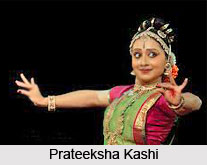 Prateeksha Kashi is an Indian Kuchipudi dancer hailing from Andhra Pradesh.
Prateeksha Kashi is an Indian Kuchipudi dancer hailing from Andhra Pradesh.
Early Life of Prateeksha Kashi
Prateeksha Kashi was born in Bengaluru, Karnataka to an artistic family. She is the daughter of the Kuchipudi dancer, Vyjayanthi Kashi. Vijaya Kashi is a television and theatre artist. She is from the family of Dr. Gubbi Veeranna and was initiated to dance at the age of five. She was trained under his mother. Prateeksha Kashi is a Computer Science Engineer. As a child, it is said that Kashi sang and danced the whole of the dance drama AMBE from the Mahabharata when she was just three years old.
Career of Prateeksha Kashi
The passion of Prateeksha Kashi extends beyond dance to acting, teaching, organizing and Nattuvangam, the art of conducting a classical Indian dance recital, which addresses the Laya or sense of rhythm, a very important aspect of Indian classical dance. With a keen interest in spreading Kuchipudi Dance and to inspire the youth towards it, she coaches aspiring dancers in Bengaluru. She began her stage debut at the age of five that occurred when she ran onto the stage when her mother was performing at the Ramana Maharshi`s Institute and started dancing in synchrony with the senior dancers of Shambhavi School of Dance next to whom she was only knee high. Since then, she has been trained in Kuchipudi under the guidance of her mother Vyjayanthi Kashi. At the age of thirteen, Prateeksha Kashi topped the state in the Kuchipudi dance exams with a distinction. Prateeksha Kashi Excelled in her studies as well. She got a gold medal for securing top rank in computer science in her Engineering College. Prateeksha Kashi did her Ranga Puja on 20th February 2009, and since then she has been recognized as the "Rising Star".
Award Received by Prateeksha Kashi
Prateeksha Kashi was honoured with Aditya Vikram Birla Kalakiran Puraskar-2014 in the field of dance by the Government of Maharashtra. She was honoured with the 37th annual Aryabhata International Award-2011 for excellence in Kuchipudi. She has the titles of Nalanda Nritya Nipuna, instituted by the renowned Nalanda Dance Research Centre and Nritya Jyoti, awarded at the Naveen Kalakar to her credits. Prateeksha Kashi was also the winner of the dance competition conducted by Pandit Jasraj"s Foundation at New York. She is the recipient of the prestigious scholarship from the Ministry of Culture. Prateeksha Kashi Received "Young Dancer" award from Sanjali School of Odissi as a part of Pravaha 2013. In the year 2014, Prateeksha Kashi received Kalabharathi National Young Talent Award, Kalabharathi Yuva Nrutha Pratibha Award, Naatyavedha Award 2014 as a part of "Jathis Music and Dance Festival".



















